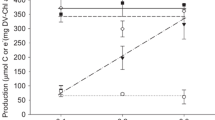Abstract
Isochrysis galbana Parke, Strain CCAP 927/1, was grown in ammonium-limited batch culture under a 12 h light: 12 h dark illumination cycle. Samples were taken every 12 h over the 26 d period from lag phase through exponential into stationary phase (no net carbon fixation), with more frequent sampling at points of interest. Exponential cell-specific growth rate was 0.3 to 0.4d-1. Cell division occurred during the dark phase, while cell volume increase, ammonium uptake, and pigment synthesis occurred during the light. Stationary phase cells were small, and the lag phase was long (5 d) even though the C:N ratio had returned from 18 to 6.5 within 2 d, followed by synthesis of chlorophyll a. Net chlorophyll synthesis ceased within 4 d of exhaustion of the nitrogen source. The chlorophyll c: chlorophyll a ratio remained constant during increasing nitrogen deprivation. Biovolume and carotenoids correlated with carbon biomass. Levels of chlorophyll a correlated poorly with carbon fixation and carbon biomass once the nitrogen source had been exhausted. Except after the addition of ammonium to nitrogen-deprived cells (refeeding), the content of intracellular glutamine and the glutamine: glutamate ratio were low during the dark phase, rising to a plateau within the first 1 h of illumination. Refeeding of cells which had only just exhausted the extracellular nitrogen source resulted in a much smaller increase in glutamine than refeeding of nitrogen-starved (stationary-phase) cells. Nitrogen biomass correlated with the presence of an unidentified intracellular amine.
Similar content being viewed by others
References
Caperon, J. (1969). Time lag in population response of Isochrysis galbana to a variable nitrate environment. Ecology 50:188–192
Davidson, K., Cunningham, A., Flynn, K. J. (1993). Modelling temporal decoupling between biomass and numbers during the transient nutrogen-limited growth of a marine phytoflagellate. J. Plankton Res. 15:351–359
Davidson, K., Flynn, K. J., Cunningham, A. (1992). Non-steady state ammounium-limited growth of the marine phytoflagelate Isochrysis galbana Parke. New Phytol. 122:433–438
Droop, M. R. (1975). The nutrient status of algal cells in batch culture. J. mar. biol. Ass. U. K. 55:541–555
Flynn, K. J. (1988). Some practical aspects of measurements of dissolved free amino acids in natural waters and within microalgae by the use of HPLC. Chem. Ecol. 3:269–293
Flynn, K. J. (1990). The determination of nitrogen status in microalgae. Mar. Ecol. Prog. Ser. 61:297–307
Flynn, K. J., Davidson, K., Leftley, J. W. L. (1993a). Carbon-nitrogen relations during the batch growth of Nannochloropsis oculata (Eustigmatophyceae) under alternating light and dark. J. appl. Phycol. 5:465–475
Flynn, K. J., Flynn, K. (1992). Non-protein free amines in microalgae: consequences for the measurements of intracellular amino acids and of the glutamine/glutamate ratio. Mar. Ecol. Prog. Ser. 89:73–79
Flynn, K. J., Zapata, M., Garrido, J. L., Öpik, H., Hipkin, C. R. (1993b). Changes in carbon and nitrogen physiology during ammonium and nitrate nutrition and nitrogen starvation in Isochrysis galbana. Eur. J. Phycol. 28:47–52
Heath, M. R., Richardson, K., Kiørboe, T. (1990). Optical assessment of phytoplankton nutrient status. J. Plankton Res. 12: 381–396
Herzig, R., Falkowski, P. (1989). Nitrogen limitation in Isochrysis galbana (Haptophyceae). I. Photosynthetic energy conversion and growth efficiencies. J. Phycol. 25:462–471
Laws, E., Caperon, J. (1976). Carbon and nitrogen metabolism by Monochrysis lutheri: measurement of growth-rate-dependent respiration rates. Mar. Biol. 36:85–97
Marker, A. F. H. (1965). Extracellular carbohydrate liberation in the flagellates Isochrysis galbana and Prymnesium parvum. J. mar. biol. Ass. U.K. 45:755–772
Renaud, S. M., Parry, D. L., Thinh, L.-V., Kuo, C., Padovan, A., Sammy, N. (1991). Effect of light intensity on the proximate biochemical and fatty acid composition of Isochrysis sp. and Nannochloropsis oculata for use in tropical aquaculture. J. appl. Phycol. 3:43–53
Ricker, W. E. (1973). Linear regressions in fishery research. J. Fish. Res. Bd Can. 30:409–434
Sukenik, A., Levy, R. S., Levy, Y., Falkowski, P. G., Dubinsky, Z. (1991). Optimizing algal biomass production in an outdoor pool: a simulation model. J. appl. Phycol. 3:191–201
Turpin, D. H. (1991). Effects of inorganic N availability on algal photosynthesis and carbon metabolism. J. Phycol. 27:14–20
Vanlerberghe, G., Schuller, K. A., Smith, R. G., Feil, R., Plaxton, W. C., Turpin, D. H. (1990). Relationship between NH +4 assimilation rate and in vivo phosphoenol pyruvate carboxylase activity: regulation of anaplerotic carbon flow in the green alga Selenastrum minutum. Pl. Physiol. 94:284–290
Author information
Authors and Affiliations
Additional information
Communicated by J. Mauchline, Oban
Rights and permissions
About this article
Cite this article
Flynn, K.J., Davidson, K. & Leftley, J.W. Carbon-nitrogen relations at whole-cell and free-amino-acid levels during batch growth of Isochrysis galbana (Prymnesiophyceae) under conditions of alternating light and dark. Marine Biology 118, 229–237 (1994). https://doi.org/10.1007/BF00349789
Received:
Accepted:
Issue Date:
DOI: https://doi.org/10.1007/BF00349789




